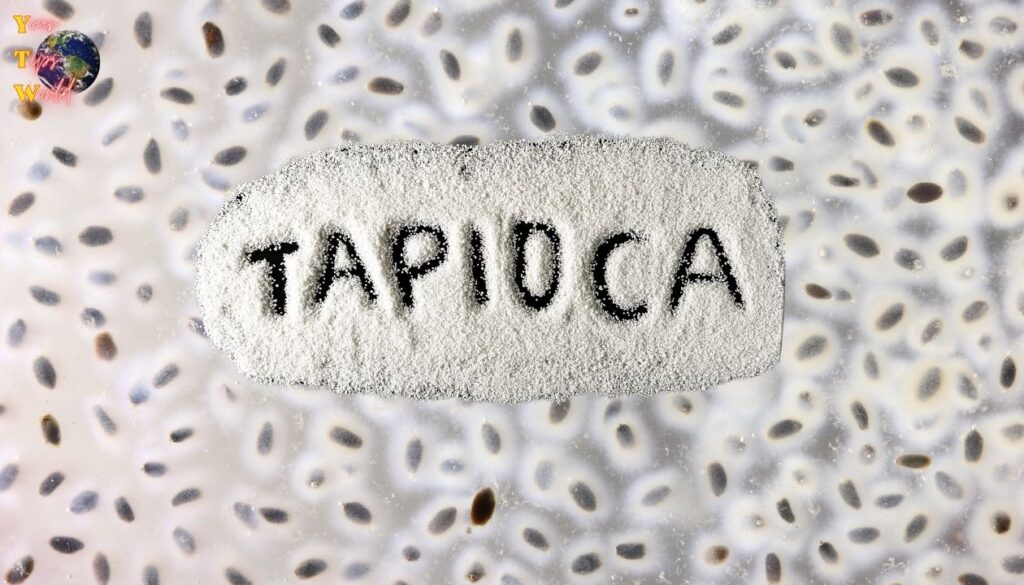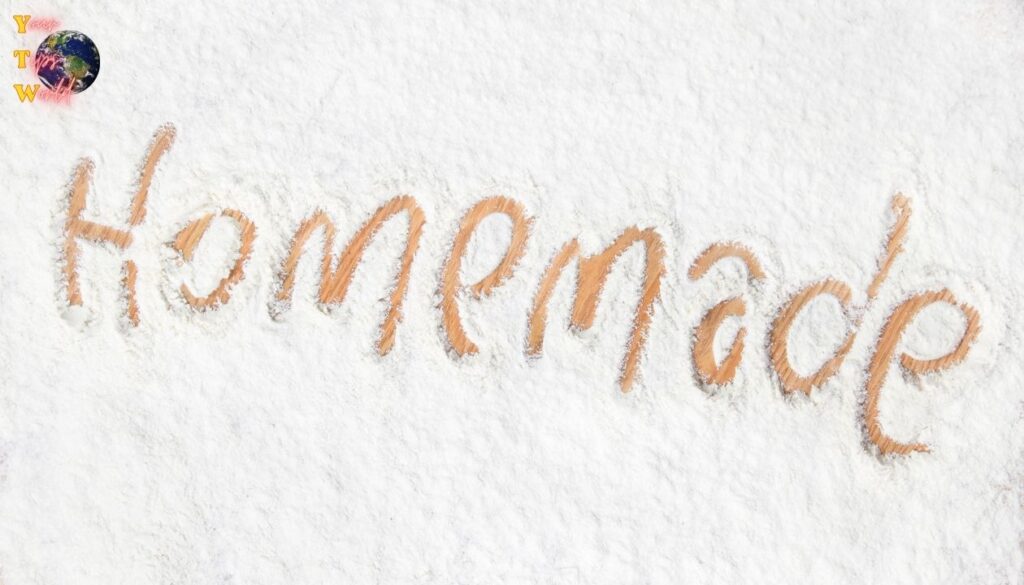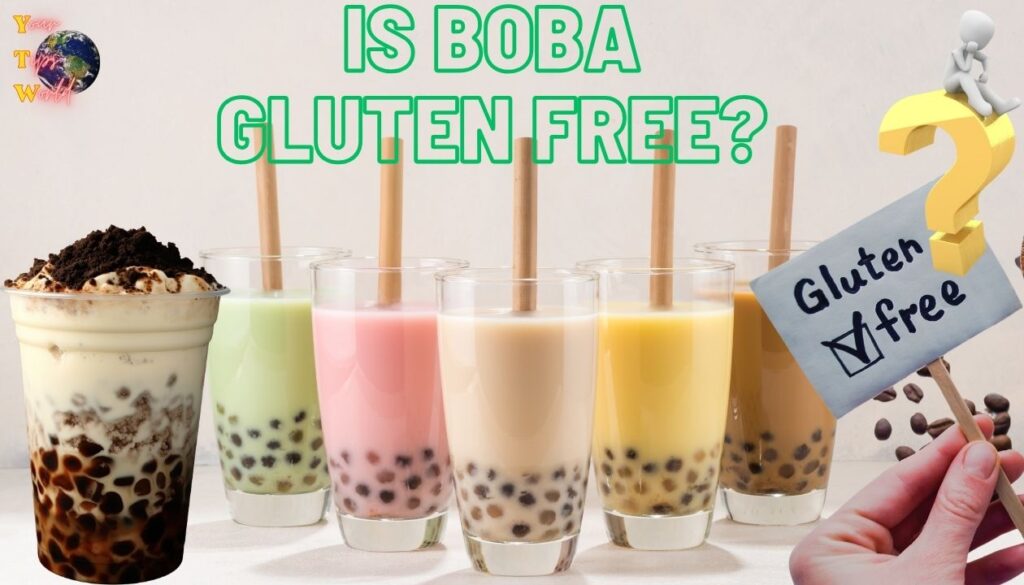Are you a bubble tea lover constantly questioning “is boba gluten free?” Individuals with gluten sensitivities have expressed alarm at the use of tapioca pearls in boba tea, sparking fearful speculation regarding its gluten content.
We offer our comprehensive guide which explores all aspects of tapioca production as well as answers the burning question: is boba gluten-free?
Tapioca, a gluten-free starch extracted from cassava root, is used as the cornerstone ingredient in creating chewy tapioca pearls used for boba tea.
While naturally gluten-free, potential cross-contamination during production or the presence of other gluten-containing ingredients must also be taken into consideration during its creation;
our exploration of different varieties of boba tea reveals potential sources of contamination while offering guidance to ensure an enjoyable boba experience for all our visitors.
Join us as we venture on an exploration of tapioca’s secrets, an analysis of boba tea components and finding gluten-free bubble tea options at shops.
Whether you are gluten free looking forward to trying bubble tea for the first time, or curious about compatibility between boba and gluten, our guide aims to equip you with all of the knowledge required for enjoying an exceptional gluten-free boba experience!
Our guide also strives to answer all questions related to it so as to provide an enjoyable boba experience while answering all related burning issues – making an interactive and engaging read that covers it all while answering all your burning queries on compatibility!
What is Tapioca?

Tapioca is a versatile starch made from the cassava root of South American plants commonly referred to as yuca. As it naturally lacks gluten, tapioca makes an excellent gluten-free food choice suitable for people living with celiac disease or gluten sensitivities.
Producing tapioca involves grinding cassava roots until their starchy liquid can be extracted before drying it into fine powder form for use as food ingredients.
Tapioca starch is not only gluten-free but can be used as a thickener in various recipes – making it a staple for gluten-free dining!
Perhaps most well known are tapioca pearls made from mixing tapioca starch with water and brown sugar that add a chewy element to bubble tea beverages!
Tapioca pearls and powder provide delicious gluten-free foods that satisfy those with restrictive dietary needs while offering delightful textures without harming health.
So long as no cross contamination takes place during preparation and handling processes, tapioca products may be enjoyed safely without fear of indulging in gluten.
Tapioca Overview
- Origin: South America
- Derived from: Cassava (Yuca) Root
- Gluten-Free Status: Naturally Gluten-Free
- Common Uses: Tapioca Pearls (Bubble Tea), Thickening Agent
- Ideal for: People with Celiac Disease or Gluten Sensitivities
Understanding Boba Tea and Is Boba Gluten Free
Boba tea, the enchanting Taiwanese drink that won over hearts across the globe, marries the simple pleasure of tea with the interactive experience of tapioca pearls.
This cultural phenomenon, known for its signature wide straws, was initially crafted in the 1980s and has seen a rise in global popularity ever since, maintaining its status as a favorite bubble tea shop fixture.
Bubble tea requires understanding its core components to fully appreciate this special beverage. At its heart is an aromatic tea base mixed with milk or fruit juices, sweeteners such as simple syrup or brown sugar and chewy tapioca pearls made from cassava plant starch for extra gluten-free enjoyment!
Understanding Is Boba Gluten Free is especially crucial for those living with celiac disease or gluten sensitivities, while its core ingredients-tea from Camellia sinensis plants and tapioca starch extracted from cassava roots-are typically gluten-free;
however, any risk of cross-contamination in bubble tea shops must always be assessed; those following a strict gluten-free diet should always inquire as to preparation methods as well as verify Is Boba Gluten Free status of additional components used such as flavors or milk teas before ordering them!
How Boba Tea is Made
Creating boba tea is both a culinary and almost artistic venture. It begins with brewing a strong base of tea; often black, green, or a specially flavored variety—all of which are inherently gluten-free.
The tea not only imparts its robust or delicate flavors but also serves as the foundation upon which the other ingredients build.
Once the tea is prepared to its flavorful peak, it’s cooled and mixed with milk or milk substitutes like almond milk, soy milk, or coconut milk, allowing for a broad taste spectrum and catering to various dietary restrictions.
The tea is then sweetened—most commonly with brown sugar or simple syrup—and poured over a generous scoop of chewy tapioca pearls, with the preparation finalized by adding ice. Boba tea drinkers are usually provided a wide straw, essential for savoring both the beverage and the textural contrast of the boba pearls.
The Different Varieties of Boba Tea
Boba tea’s variety is as rich as its influence across cultures worldwide.
Popular choices of Boba include
- Robust black, fragrant oolong and delicate white varieties;
- Aromatic jasmine jasmine blends;
- Delicate white tea for its floral notes, aromatic jasmine tea;
- Fresh tasting green matcha;
all providing their own distinct narrative in cup form with powerful antioxidants to soothing aromas without gluten ingredients added into it!
The variety extends beyond the tea leaves to milk choices, with tea shops offering both traditional dairy and a selection of plant-based alternatives to please all palates.
As preferences shift and awareness of dietary needs such as gluten sensitivities increases, bubble tea shops are adapting.
Yet, vigilance is key for those with gluten intolerances or celiac disease, as the intricacies of preparation methods and added flavorings in your favorite bubble tea shop could introduce a risk of cross-contamination.
By remaining informed about these factors, tea enthusiasts with dietary restrictions can continue to enjoy their cherished chewy tapioca pearl-laden drinks without concern.
Are Tapioca Pearls Gluten-Free?
Tapioca pearls, the chewy balls at the bottom of a bubble tea cup that derive their chewy texture from cassava root starch, are naturally gluten-free foods and an indulgent option for celiac disease sufferers and others following strict gluten-free diets.
Cassava doesn’t produce proteins present in wheat, barley, rye and other gluten-containing grains like other grains do so pure tapioca starch does not contain gluten.
Gluten-sensitive individuals should ensure when selecting tapioca pearls they meet FDA’s gluten-free standard of less than 20 parts per million (ppm), to make sure they comply.
While pearls in their basic state should be devoid of gluten altogether, those avoiding gluten must take caution in selecting their pearls;
checking labels to confirm certified gluten-free status could decrease risks that these may have come into contact with gluten during processing due to sharing facilities or equipment used with wheat flour products or other sources that contain it.
What is Cassava Root and Tapioca Starch?
The cassava root, a tuber native to South America, is the essential source for producing gluten-free tapioca starch. Harvested from the tropical cassava plant, the root resembles a rugged sweet potato and is ground into a powdery substance after a careful extraction process.
This fine powder becomes the tapioca starch used in a wide array of gluten-free products, and when mixed with water and sometimes brown sugar, it forms the signature boba pearls commonly found in bubble tea.
Tapioca starch is favored across many gluten-free recipes due to its smooth texture and ability to mimic the chewiness that gluten often provides in baking.
It’s a trusted ingredient in the gluten-free culinary world, offering versatility in thickening sauces, creating crispy crusts, and producing the beloved chewy texture of boba pearls.
Understanding Cross-Contamination
Cross-contamination is a serious threat for those living with celiac disease and gluten sensitivities, and may occur at various points during processing, preparation and serving of tapioca pearls despite them naturally being gluten free.
Even in their original production environment containing wheat products that also process them could result in contamination; equipment, containers or utensils not thoroughly washed between uses may harbor residual gluten that subsequently transfers itself onto gluten-free items unwittingly.
To safeguard against this risk, consumers should vigilantly seek out tapioca pearls that are marked as certified gluten-free.
They should also enquire about the handling practices when frequenting bubble tea shops to ensure the absence of gluten cross-contamination in the preparation of their tea drink.
Awareness and communication are pivotal to ensure the gluten-free integrity of boba pearls from production to the point of enjoying a sip.
Naturally Gluten-Free and Gluten Ingredients
The intrinsic attributes of boba pearls, popping boba, and tapioca starch hail them as superior choices for a gluten-free diet.
Cassava root’s starch is naturally devoid of gluten and serves as the sole base for traditional boba pearls, accompanied by water and sometimes a touch of brown sugar. In addition, the simple syrup and fruit juices commonly used in bubble tea are typically gluten-free, and with the right oversight, the ensuing tea drink should harmonize with gluten-free eating.
However, vigilance remains essential, as boba tea variations might incorporate other gluten-containing ingredients. This includes certain flavored syrups, perhaps derived from barley, or additives that introduce gluten into an otherwise safe beverage.
Moreover, milk bases and flavorings can pose hidden gluten threats and must be scrutinized. Meticulously checking labels, asking bubble tea shop staff about ingredients, and prioritizing certified gluten-free options can go a long way in navigating a gluten-free lifestyle without relinquishing the pleasures of bubble tea.
Navigating Bubble Tea Shops with Gluten Sensitivities
When entering the delightful realm of bubble tea shops, those with gluten sensitivities must tread with caution. Tapioca pearls are the star of the show in bubble tea, and they are traditionally made from gluten-free tapioca starch.
Vigilance is crucial in order to avoid cross-contamination risks when producing pearls in facilities that also handle wheat flour or gluten-containing ingredients.
To hold onto your gluten-free diet, always enquire with the bubble tea shop staff about the specific types of milk and sweeteners used in their beverages. Not all milk alternatives are created equal—while options like almond milk are typically gluten-free, others may not be. Similarly, sweeteners such as brown sugar and simple syrup are usually safe, but always confirm that flavorings and additives do not compromise your gluten-free requirements.
Here’s a checklist to guide you through securing a gluten-free bubble tea experience:
- Ask the Staff: Inquire about their gluten-free options and cross-contamination practices.
- Check Ingredient Labels: Where available, review lists of ingredients or allergen information.
- Verify Milk Alternatives: Ensure that dairy-free options like almond or oat milk are gluten-free.
- Safe Sweeteners: Confirm the gluten-free status of any sweeteners or flavor syrups used.
- Chain Restaurants: Many boba chain restaurants like ShareTea offer options that cater to gluten sensitivities; however, verification with the staff is paramount.
- Watch the Preparation: If possible, observe how your bubble tea is being prepared to ensure no gluten-containing products are used in the process.
By taking these proactive steps, you can savor the unique combination of tea, milk, and the chewy tapioca balls without compromising on health or flavor.
Tips for Finding Gluten-Free Options at Tea Shops
For those devoted to maintaining a gluten-free diet, choosing the right bubble tea shop can make all the difference. Here are some tips to help you find your favorite bubble tea shop that caters to your dietary restrictions:
- Research Ahead of Time: Look up bubble tea shops online and check their menu for indications of gluten-free options. Often, businesses will highlight their allergy-friendly offerings.
- Reading Reviews: Utilizing customer reviews can give insight into how well a shop accommodates gluten-free needs.
- Customer Service: Don’t hesitate to contact the bubble tea shop prior to your visit. A quick call can answer questions about gluten-free options and preparation methods.
- Local Recommendations: Reach out to local gluten-free communities or forums for their favorite bubble tea shop recommendations, as they’ve likely done the investigative work already.
- Certification Verification: Consider certified gluten-free bubble tea options for utmost safety. Some shops may proudly display their certifications or adherence to gluten-free standards.
By using these tips, you can enjoy a delightful cup of bubble tea with peace of mind, knowing that your beverage aligns with your gluten-free lifestyle.
Favorite Bubble Tea Shops with Gluten-Free Choices
Among the plethora of choices, some bubble tea shops stand out for their commitment to providing gluten-free options that don’t skimp on taste or variety. These establishments understand the importance of safe and inclusive options for all their customers.
- ShareTea: Renowned for its extensive menu, ShareTea offers a wide array of gluten-free flavors and add-ons, making it a top choice for those on a strict gluten-free diet.
- Local Specialty Shops: Often, local bubble tea cafés are more flexible and aware of their customer’s dietary needs. These shops may provide custom gluten-free options and employ careful preparation methods to minimize cross-contamination.
Finding a bubble tea shop that respects and caters to gluten-free diets can transform your tea drinking experience.
Do your homework, ask the right questions, and you may discover a favorite spot that becomes your go-to for gluten-free indulgence.
Making Gluten-Free Bubble Tea at Home

Home-brewed gluten-free bubble tea can be both enjoyable and safe experience for those on a gluten-free diet.
Homemade boba’s irresistibly tempting appeal lies in its naturally gluten-free ingredients such as tea, milk, tapioca pearls and sweetener; certified gluten-free popping boba can ensure it remains entirely gluten-free when making homemade drinks!
For optimal results and safety of gluten-sensitive individuals consuming homemade drinks.
Choosing Gluten-Free Ingredients
When handcrafting your bubble tea, vigilance in ingredient selection is paramount. First and foremost, verify that your tapioca pearls are certified gluten-free.
These chewy treats are derived from cassava root, a naturally gluten-free starch, but the certification ensures they haven’t been cross-contaminated. Next, consider the milk or creamer.
Whether you go for a dairy or a non-dairy option like almond milk, ensure that it’s explicitly labeled gluten-free.
If opting for plant-based milk, such as oat milk, exercise caution, as oats can be contaminated with gluten unless processed in a strictly gluten-free facility.
Moreover, traditional mochi, a delightful and gooey topping, is traditionally made from glutinous rice flour and is gluten-free.
However, always check labels for certification as a preventive measure. For sweeteners, simple syrup—comprising sugar and water—is inherently gluten-free, offering a sweet touch without the gluten.
As an alternative to classic sweeteners like brown sugar, fruit juices are a delightful, natural option that you can trust to be gluten-free.
Preparation Methods to Avoid Cross-Contamination
Even with all of the appropriate gluten-free ingredients in hand, proper preparation is critical in avoiding cross-contamination.
When creating tapioca pearls or making other gluten-free treats like breadsticks or muffins it’s advisable to use only tools and equipment dedicated exclusively for gluten-free cooking (strainers, spoons or blenders that haven’t ever come into contact with gluten).
A pot reserved exclusively for gluten-free cooking could further protect from exposure.
Educating oneself on proper cleaning methods is essential. All equipment must be thoroughly cleaned before use, even if they are designated as gluten-free, to eliminate the chance of gluten residues from shared kitchen spaces.
It is also wise to have a separate preparation area, if possible, to mitigate any risk associated with gluten-containing particles in the air or on surfaces.
Simple Syrup and Fruit Juice as Alternatives to Brown Sugar
Simple syrup can be an ideal sweetener option for bubble tea drinkers looking to adhere to a gluten-free diet, since its two ingredient composition (sugar and water) makes it naturally free from gluten. Furthermore, this sweetener provides smooth and consistent sweetness without compromising taste!
Fruit juice offers another healthful sweetener alternative that provides not only sweetness, but also an irresistibly fruity note to bubble tea;
an ideal way to infuse natural flavor without risk. By substituting brown sugar with simple syrup or fruit juice, those who are sensitive to gluten can still experience homemade boba tea’s exquisite experience without fearing possible negative health impacts from its gluten content.
Homemade bubble tea preparation requires using gluten-free sweetener options that not only maintain gluten-free integrity, but offer flexibility of flavor and sweetness level.
Explore various combinations until one meets your palette perfectly!
